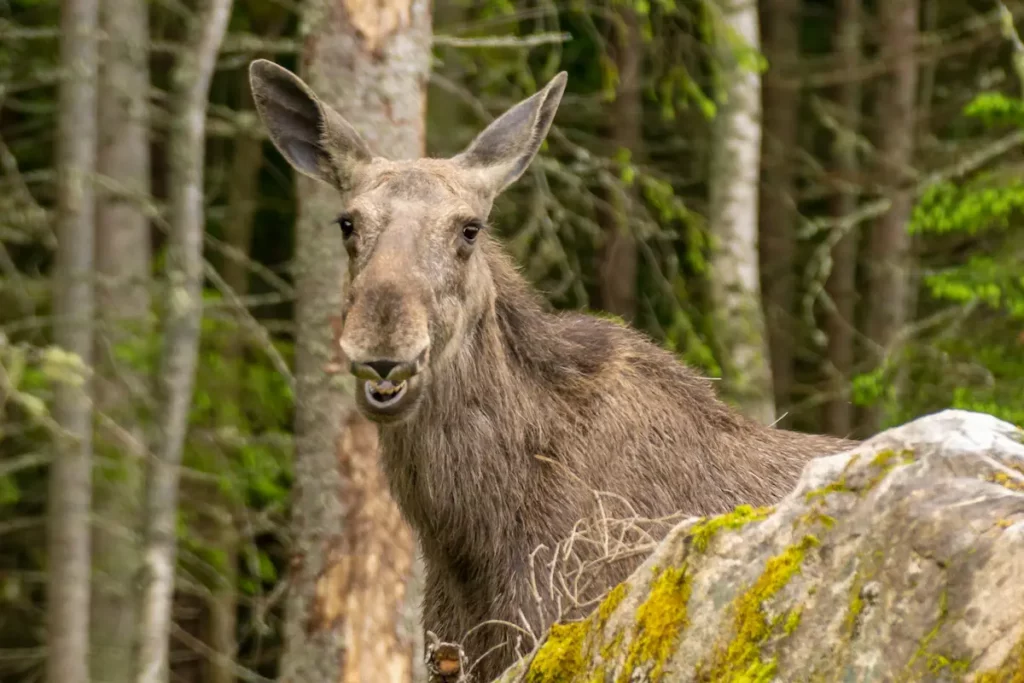Moose do not have ivory teeth. Their teeth are made of calcium, phosphorus, some dentine, and enamel, just like many other creatures, including humans. However, other members of the deer family, most famously Elk, do in fact have ivory teeth, but it isn’t their entire jaw that is made of ivory, only two teeth are.
We all know that animals with tusks have ivory in said tusks, such as elephants and walruses, but how can it be that so many people believe something like a moose has ivory teeth?
Keep reading to learn more about how this myth of the moose may have had its roots and what the big deal is about ivory, for both indigenous peoples and the animal.

Related Reading: Does It Hurt For Moose When They Shed Velvet?
Ivory Teeth in the Deer Family
While the idea that moose have ivory teeth may seem like a bizarre thing to believe, It’s not an entirely ridiculous thing to think about. Moose are a part of the deer family, Cervidae, and so are elk. This is significant because elk are known to have two ivory teeth, one on each side of its upper jaw where canines ought to be. That is, between the molars and front of the muzzle. They aren’t born with them but develop them after three weeks of age. Then, they grind them down with time, so the older they are, the shorter their ivories are.
White-tailed deer can also be found with these upper canines, known as ivories, but it’s exceptionally rare. In fact, prolific white-tailed deer researcher, C.W. Severinghaus, studied 18,000 of these deer, and only 23 were found to have these canine ivories.
This would mean that maybe not every member of the deer family has ivory teeth, and indeed unless ivory canines in moose are just much rarer than in white-tailed deer, these giants just do not have ivory teeth, neither in their youth or old age.
If elk have ivory teeth, but moose do not, what do the Elk use their ivory teeth for that moose have no need of?
What was Ivory From the Deer Family Used For?
It’s not entirely clear why Elk have this ivory, but they do put them to use. When an elk perceives a threat, they show them off when they are warning potential threats to back off. The elk’s first warning is to show a tooth in a snarl, then he grinds or clicks his tooth at the threat.
Yet, this probably isn’t the only reason for elks to have these ivory teeth, because moose also click their teeth. They don’t need ivory in their teeth for the purpose of intimidating predators thanks to their size, bad tempers, and usually their antlers, during mating season. If they have to show signs of aggression, they raise the hair on their humps, urinate, show the whites of their eyes, or begin advancing toward the threat, in addition to other potential signs. They don’t need the animal kingdom equivalent of a reflective patch on a cyclist’s coat.
The ivory in the deer family was valued by the Native Americans also. They valued the deer enamel highly, to the point where they were used as currency. Today, they are valued by craftsmen and women who can use ivory in jewelry or other decors.
What Moose Teeth are Made of
Normal teeth for mammals are composed of pulp, dentin, enamel, and cementum. Regular teeth are a collection of calcium, dentin(e), phosphorus, and enamel, as the hard ingredients. Ivory in animals is the same, except it has a much higher concentration of dentine.
An important distinction of ivory is that the word “ivory” is used to label any mammal’s tooth or tusk that has commercial value and interest. Naturally, actual ivory that usually lies directly underneath a tooth’s enamel layer is going to be more valuable for its properties as a tough, but easily carved material and lustrous appearance.
We regard elk as having real ivory because their two ivory teeth have the same composition as tusks from elephants or walruses do. However, moose teeth are not made of the same composition as ivory or even have the color of ivory, so don’t have the desired properties, making them useless as far as harvesting goes.
Moose Jaw Structure
It’s possible one reason moose don’t have these ivory canine teeth is that they don’t serve a purpose in effectively eviscerating what a modern moose eats. A moose’s diet primarily consists of wild flowering plants, twigs, bark, leaves, and especially marsh and other aquatic plants.
Their jaw structure accounts for their diet perfectly with 6 large incisors at the very front of their muzzles to initially collect their food, then they have 12 rigid molars in their upper and lower jaws, as well as 3 premolars on each side that are used for chewing and grinding the food the incisors collected. Moose does have 2 canines already, but they have a normal tooth composition like the rest of their teeth.
Then, there is just a large space in between the incisors and canines, and the premolars and molars. Altogether, moose have 32 teeth but no sign of Ivory.
Why Don’t Moose Have Ivory?
The general opinion among researchers as to why elk have ivory teeth is because they had an ancestor elk that had fully-fledged tusks as large as eight inches long, and the elk today have the remnant tusk genes of that ancestor. Meanwhile, it isn’t believed that moose ever had such an ancestor, so they don’t have any form of lingering ivory genetics.
Conclusion
So, while Moose don’t have ivory of any sort, likely because they don’t need it for any form of protection as elephants do, or to ward off threats as elk do, you can click away from this article knowing that ivory is in more animals than you might have first thought.
